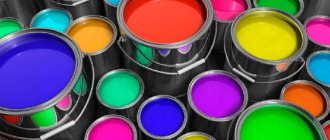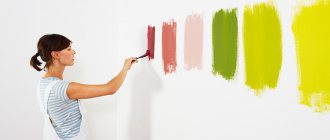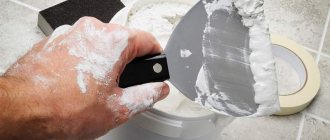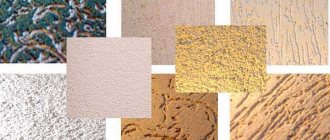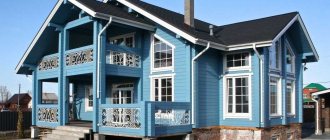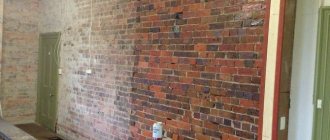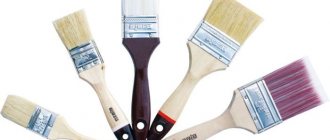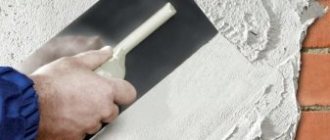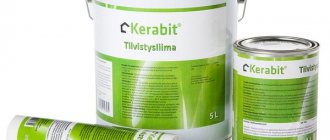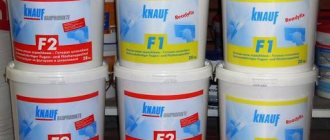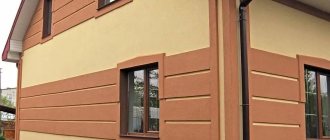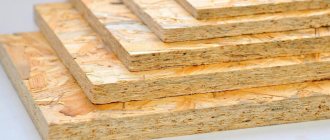Classification of coloring compositions
Paints are classified according to several main characteristics:
- Purpose – universal, for interior or exterior work.
- Type of solvent – water-soluble (water-based) and with organic solvent (white spirit, kerosene).
- Level of gloss – matte, semi-matte, semi-gloss and glossy.
- Operating conditions – weatherproof, waterproof, special, electrical insulating and others.
- Surface type – wood, metal, concrete, rust, brick, plaster.
The most significant component that determines the physical and chemical properties of paint is the binder. The film-forming agent is based on natural or synthetic drying oil, minerals, resins, and polymers.
Water based paints
Water-dispersion paints are the optimal choice for interior finishing work. The solvent in them is water, which eliminates the appearance of an unpleasant odor. The environmentally friendly composition is safe for health, fire resistant, and vapor permeable . The suspension contains fillers, coloring pigments and additives. After the water evaporates, the fine particles form a durable coating on the surface. The basis of the paint is film-forming substances.
Emulsion
An emulsion is a composition obtained from small insoluble particles of polymers and pigments suspended in water. Paintwork works well on any surface, except those previously painted with glossy paints or varnishes. It is economical to use, dries quickly and has no odor. Emulsions are resistant to moisture and alkalis and do not peel off. Their properties depend on the type of binder.
Acrylic
A universal product recommended for painting work indoors and outdoors. The paint binder is acrylic polymer. An elastic, frost-resistant, vapor-permeable film that is resistant to fading is formed on the surface to be finished. Acrylic compositions differ from oil-based materials in their drying speed; it varies from 20 minutes to several hours. The formed film can be washed. The coating lasts more than 10 years.
Acrylic compositions are sold in regular jars and spray cans. The technology of applying paints and varnishes allows for high-quality treatment of hard-to-reach areas, without the use of painting tools (brushes and rollers).
Latex
Rubber (latex)-based paints form a durable and moisture-resistant film on the surface. The coating is durable and environmentally friendly. The composition is easily applied with a brush, roller or spray.
Latex material is recommended for rooms with increased requirements for durability, reliability and durability of the finish. The only drawback is the average UV resistance.
PVA
Polyvinyl acetate paints are dispersions with low water resistance intended for dry rooms. They dry quickly and give a rich color. The product is offered ready-made and does not require dilution. A significant advantage is the low price.
Adhesive compositions
Painting compositions based on adhesive mixtures also belong to the group of water-soluble ones. Recommended only for dry rooms . They are not resistant to moisture, abrasion, or the appearance of microorganisms. Used for painting plaster, concrete, brick, plasterboard. The paints and varnishes contain chalk, starch, glue (casein, glutin, albumin), pigments and fillers. Water is used to dilute the dry product.
Casein
The product forms a stable film, thanks to which it can be applied not only indoors, but also on the facade. In production, casein glue, chalk, alkali-resistant pigments, alum and water are used. The composition is recommended for durable surfaces (concrete or plastered). It is diluted immediately before use on the construction site.
Dextrinated
Products based on dextrin, isolated from starch, are made with the addition of bone glue . After drying, the porous coating allows air and moisture to pass through well. A solution from dry powder is prepared 1:1. To enhance water resistance, drying oil is added (60-70 ml per 1 l).
The disadvantages of all adhesive compositions include heterogeneity, difficulty of application, and low decorative characteristics.
Silicone
The advantages of coatings based on organosilicon resins include ease of application, low cost, and versatility. The water-dispersed composition is odorless, vapor permeable, resistant to temperature changes, the action of microorganisms, moisture and sunlight.
The product is universal, suitable for any surface, and can be applied to the facade.
Due to its viscous structure, no special preparation of the base is required; silicone material is able to mask small cracks. Disadvantages include the high cost of coatings, as well as possible corrosion of the metal due to the gas permeability of the coating.
Tools for working with interior paint
Painting compounds are applied to the surface using brushes, sprayers and rollers, it all depends on the size of the room.
Brushes of different widths will help you paint hard-to-reach places well.
With the help of rollers, you can paint large areas of the room at once, and the spray gun is suitable for applying only some types of paint for interior decoration, for example, water-dispersed ones.
To paint the ceiling surface, rollers of different widths are used. Most often, such a tool is used to work with quick-drying compounds.
Using a roller, you can evenly and quickly distribute the mixture over the surface without streaks or gaps.
Odorless, water-based interior paints dry quickly and wash off easily from tools and skin. To cover the floor, it is best to use paints for interior wood finishing - odorless oil paints. The main characteristics of such compositions are high wear resistance and moisture resistance.
It is most convenient to apply oil paints for the interior decoration of a wooden house with a roller, or with a brush or spray. To enhance the protective properties of the painted surface, you can apply varnish on top.
Odorless acrylic paints are most often used to coat wooden structures - doors and windows. Before painting, wooden products must be prepared, puttied and all cracks repaired. It is best to apply such compositions with a brush. When using paint for the interior decoration of wood, the following must be taken into account: wood is capable of absorbing the composition, so one layer is not enough; you will need to coat the surface again, but only after the first layer has dried well.
Organic solvent paints
High quality coatings and affordable prices allow organic solvent-based materials to compete with more environmentally friendly and safe water-dispersed paints. Leading manufacturers are reducing their number in their assortment, but not completely abandoning them. Compositions based on oil processing and various resins can be applied at low temperatures; a fresh coating is not afraid of moisture.
Alkyd
Paints and varnishes based on alkyd resins are classified as enamels . They come in two types: pentaphthalic and glyphthalic . For painting work at home, the first option is most often used. Alkyd enamels are characterized by high covering power and resistance to mechanical damage, frost, and moisture. The composition is easy to apply, has a pronounced shine, and is compatible with wood and metal. The disadvantage of the material is the release of toxic substances during the drying process and poor vapor permeability.
Oily
Oil paint contains toxic pigments (lead white, titanium dioxide), fillers, natural or combined drying oil .
Paintwork materials emit a strong chemical odor that is harmful to health. You can only work with it in a well-ventilated area or outdoors. Despite their toxicity, oil-based compounds are used in construction and repair. Their demand is associated with positive characteristics: high moisture resistance, coating durability, and affordable cost.
Enamel
Enamel is a composition of varnish, pigments and solvent . It is suitable for painting metal, wood, concrete and brick surfaces. The resulting coating has a glossy shine and is resistant to abrasion, sunlight, and water.
If it is necessary to quickly dry the finish, preference is given to nitro enamels.
Mineral paints
Facade finishing is carried out with special compounds developed for mineral surfaces. Such paints are diluted with water, have good vapor permeability, and are environmentally friendly. To increase frost resistance, synthetic resins are added to them.
Silicate paints
Paintwork materials contain one component - liquid glass with the addition of ethyl silicate , making it an excellent option for painting textured and smooth facades and interior spaces. The composition is characterized by strength, biological resistance, and non-flammability. Silicate paint is recommended for concrete, plaster, brick, clay, but it is incompatible with wood and plastic.
Lime compounds
The binder of the product is slaked lime. Inorganic pigments are used, additives include aluminum alum, calcium chloride, and salt . The paint is resistant to moisture and temperature changes, its main advantage is its low cost.
Requirements for paints
Modern paints used as decorative coatings must meet the following requirements:
- resistance to wet and dry cleaning;
- resistance to fading;
- good hiding power;
- wear resistance;
- durability;
- maintainability;
- environmental safety;
- resistance to pollution;
- affordable price.
It has now become clear that types of paints are a very broad topic. I wonder what will happen next?
Now watch an interesting video about how to choose paint for walls and ceilings:
as well as for metal, wood and concrete: And here, you can find out what rubber paint is and where it is used.
Criterias of choice
Correctly chosen finishing emphasizes the dignity of the room, making it stylish and attractive. But not only the aesthetic component of the decor is important when purchasing paints and varnishes. Having studied the types of paints, you should pay attention to their purpose: for interior or exterior use. Safety, resistance to moisture, negative temperatures and external influences depend on this characteristic.
For interior work
The main requirements for paint and varnish products for interior decoration are environmental friendliness . The composition should not emit toxic substances or a pungent odor. Also important are resistance to abrasion, sunlight, drying time and service life . For rooms with high humidity, waterproof paints (silicate, latex) are selected. Based on the selection criteria, experts advise purchasing water-dispersed formulations.
For external work
Facade paints are used in difficult conditions, so they must be resistant to low and high temperatures, moisture, mechanical stress, ultraviolet radiation, and have good adhesion .
The type of base must be taken into account. Wood requires a moisture-proof material that protects against insects, rot and cracking. For concrete and brick, a vapor-permeable coating is recommended.
Valera
The voice of the construction guru
Ask a Question
An important characteristic of paint is hiding power - the ability to cover the base surface. It is directly related to product consumption. If the indicator is low, the composition will have to be applied in 2-3 layers. The price of paints and varnishes plays a significant role in the choice. Quality products cost more, but they are safe, durable and create an attractive finish.
Comparison of the presented compositions
Paints and varnishes differ in the base base, pigment characteristics and solvents that determine drying time. The owner of an apartment or residential building who decides to independently renovate the premises needs to select enamels depending on the type of work.
To select, you can use the factory instructions or contact a consultant at a building materials store.
Scope of use
The scope of application of enamels depends on the base used:
- Water-based paints are intended for external and internal use, but the characteristics of the coating should be taken into account. For example, emulsion materials are intended for painting any surface, except for products coated with adhesives or glossy enamel. Acrylic enamels are used for painting window frames and blocks, door frames and canvases. Before application, uneven surfaces are filled with putty and a layer of primer is applied to reduce the absorbency of the plaster or wood.
- Latex compounds are recommended for use in rooms with high humidity (for example, in the bathroom or kitchen). For application, use a roller or spray.
- Alkyd enamels are used to paint heating radiators, door and window blocks. The coating is characterized by increased strength and does not collapse due to temperature deformations. It is allowed to use varnish-based alkyd enamels that provide a smooth and shiny surface instead of alkyd enamels. All synthetic enamels emit toxic fumes; the materials should not be used for painting children's rooms.
- Silicate compounds are designed for painting external surfaces. The alkali they contain has a negative effect on the eyes and skin, so before performing work it is necessary to wear safety glasses and gloves. The coating does not protect the base from water; before application it is recommended to level the surfaces and seal cracks.
- Special dyes are based on a water or synthetic base and, due to the introduction of additives, have limited applicability. For example, aerosols are used for painting small products or for minor repairs.
Color palette
The range of shades of paints and varnishes depends on the manufacturer. Manufacturers allow tinting of water-based enamels upon sale.
Thanks to a service such as computer tinting, you can get any shade of paint.
At the buyer's request, a portion of pigment is introduced into the white material (selection is carried out using a computer in accordance with RAL tables), and then the components are mixed on a vibration stand. It is recommended to prepare a batch of enamel with a reserve; when re-tinting, shade deviations may occur. Materials based on a synthetic base are supplied ready for application (the addition of pigment is not provided).
Advantages and disadvantages
The positive aspects of water-based materials include:
- environmental friendliness (enamels do not emit harmful fumes; a slight odor may be felt during painting and drying);
- resistance to alkaline solutions, moisture (repeated washing is allowed);
- the ability to maintain the original shade when exposed to sunlight;
- fast polymerization (from 1 to 6 hours depending on external conditions);
- ease of repainting and long service life.
Disadvantages noted by painters:
- low resistance to low temperatures;
- Painting surfaces with a glossy finish is not allowed;
- reduced mechanical strength (compared to synthetic-based enamels).
When using synthetic paints, their positive aspects should be taken into account:
- durability of the coating that can withstand impacts;
- no shrinkage during polymerization;
- speed of hardening.
At the same time, it is necessary to remember the shortcomings. When painting and drying, toxic vapors of solvents and resins, which have a pungent and unpleasant odor, enter the air. The dense layer that forms does not allow air and water vapor to pass through, and the wooden base can swell and rot. Enamels are flammable (vapors form explosive mixtures when mixed with air). You should also take into account the low resistance of the paintwork to alkaline solutions.
